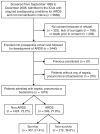The influence of infection sites on development and mortality of ARDS
- PMID: 20229040
- PMCID: PMC3116923
- DOI: 10.1007/s00134-010-1851-3
The influence of infection sites on development and mortality of ARDS
Abstract
Objective: Infection is the most frequent cause of acute respiratory distress syndrome (ARDS). However, little is known about the influence of infection sites on ARDS. This study aimed to assess the associations of infection sites with ARDS development and mortality in critically ill infected patients.
Design: Prospective observational study.
Setting: Adult intensive care units (ICUs) of an academic medical center.
Patients: Study population included 1,973 consecutive patients admitted to ICUs with bacteremia, pneumonia or sepsis. During follow-up, 549 patients developed ARDS and 212 of them died within 60 days.
Main results: The distribution of infection sites in ARDS patients was: lung (77.2%), abdomen (19.3%), skin/soft tissues (6.0%), urinary tract (4.7%), unknown (2.6%), and multiple sites (17.7%). On multivariate analysis, lung was the only infection site associated with increased ARDS risk [adjusted odds ratio (OR) 3.49]. Urinary tract (adjusted OR 0.43), skin/soft tissue (adjusted OR 0.64), and unknown-site infections (adjusted OR 0.38) were associated with decreased risk. No association was found between individual infection site and ARDS mortality. However, unknown-site [adjusted hazard ratio (HR) 3.08] and multiple-site infections (adjusted HR 1.63) were associated with increased ARDS mortality. When grouping patients into pulmonary, nonpulmonary, and combined infections, nonpulmonary infection was associated with decreased ARDS risk (adjusted OR 0.28) and combined infections was associated with increased ARDS mortality (adjusted HR 1.69), compared with pulmonary infection.
Conclusions: In critically ill infected patients, pulmonary infection is associated with higher risk of ARDS development than are infections at other sites. Pulmonary versus nonpulmonary infection significantly affects ARDS development but not mortality.
Figures
References
-
- Ware LB, Matthay MA. The acute respiratory distress syndrome. N Engl J Med. 2000;342:1334–1349. - PubMed
-
- Phua J, Badia JR, Adhikari NK, Friedrich JO, Fowler RA, Singh JM, Scales DC, Stather DR, Li A, Jones A, Gattas DJ, Hallett D, Tomlinson G, Stewart TE, Ferguson ND. Has mortality from acute respiratory distress syndrome decreased over time? A systematic review. Am J Respir Crit Care Med. 2009;179:220–227. - PubMed
-
- Rubenfeld GD, Herridge MS. Epidemiology and outcomes of acute lung injury. Chest. 2007;131:554–562. - PubMed
-
- Matthay MA, Zimmerman GA, Esmon C, Bhattacharya J, Coller B, Doerschuk CM, Floros J, Gimbrone MA, Jr, Hoffman E, Hubmayr RD, Leppert M, Matalon S, Munford R, Parsons P, Slutsky AS, Tracey KJ, Ward P, Gail DB, Harabin AL. Future research directions in acute lung injury: summary of a National Heart, Lung, and Blood Institute working group. Am J Respir Crit Care Med. 2003;167:1027–1035. - PubMed
Publication types
MeSH terms
Grants and funding
LinkOut - more resources
Full Text Sources


